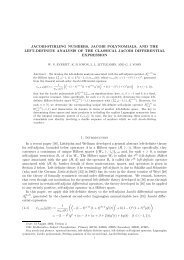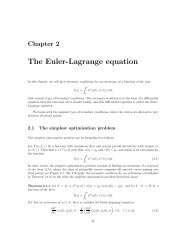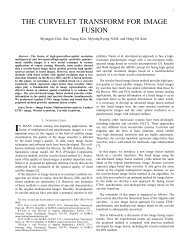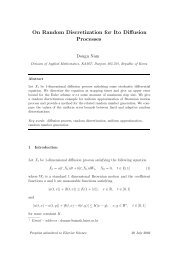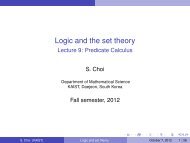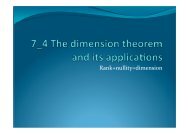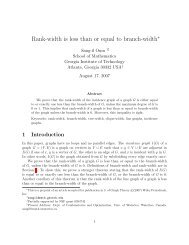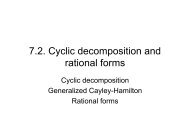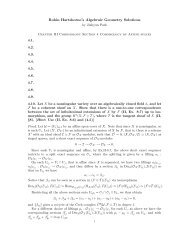A decomposable graph and its subgraphs
A decomposable graph and its subgraphs
A decomposable graph and its subgraphs
Create successful ePaper yourself
Turn your PDF publications into a flip-book with our unique Google optimized e-Paper software.
A <strong>decomposable</strong> <strong>graph</strong> <strong>and</strong> <strong>its</strong><br />
sub<strong>graph</strong>s<br />
Sung-Ho Kim 1<br />
Division of Applied Mathematics, Korea Advanced Institute of Science <strong>and</strong><br />
Technology, Daejeon, 305-701, South Korea.<br />
Abstract:<br />
We explore the properties of sub<strong>graph</strong>s (called Markovian sub<strong>graph</strong>s) of a <strong>decomposable</strong><br />
<strong>graph</strong> under some condition. For a <strong>decomposable</strong> <strong>graph</strong> G <strong>and</strong> a collection<br />
γ of <strong>its</strong> Markovian sub<strong>graph</strong>s, we show that the set χ(G) of the intersections of all<br />
the neighboring cliques of G contains ∪ g∈γ χ(g). We also show that χ(G) = ∪ g∈γ χ(g)<br />
holds for a certain type of G which we call a maximal Markovian super<strong>graph</strong> of γ.<br />
Keywords: Edge-sub<strong>graph</strong>; Markovian sub<strong>graph</strong>; Markovian super<strong>graph</strong>; Prime separator.<br />
1 Introduction<br />
Graphs are used effectively in representing model structures in a variety of research<br />
fields such as statistics, artificial intelligence, data mining, biological science,<br />
medicine, decision science, educational science, etc. Different forms of <strong>graph</strong>s are<br />
used according to the intrinsic inter-relationship among the r<strong>and</strong>om variables involved.<br />
Arrows are used when the relationship is causal, temporal, or asymmetric,<br />
<strong>and</strong> undirected edges are used when the relationship is associative or symmetric.<br />
Among the <strong>graph</strong>s, triangulated <strong>graph</strong>s [1] are favored mostly when Markov<br />
r<strong>and</strong>om fields ([11, 7]) are considered with respect to undirected <strong>graph</strong>s. When a<br />
r<strong>and</strong>om field is Markov with respect to a triangulated <strong>graph</strong>, <strong>its</strong> corresponding probability<br />
model is expressed in a factorized form which facilitates computation over<br />
the probability distribution of the r<strong>and</strong>om field [7]. This computational feasibility,<br />
among others, makes such a Markov r<strong>and</strong>om field a most favored r<strong>and</strong>om field.<br />
The triangulated <strong>graph</strong> is called a rigid circuit [4], a chordal <strong>graph</strong> [5], or a<br />
<strong>decomposable</strong> <strong>graph</strong> [9]. A survey on this type of <strong>graph</strong>s is given in [2]. One of<br />
the attractive properties (see Chapter 4 of [6]) of the triangulated <strong>graph</strong> is that<br />
<strong>its</strong> induced sub<strong>graph</strong>s <strong>and</strong> Markovian sub<strong>graph</strong>s (defined in section 2) are triangulated.<br />
While induced sub<strong>graph</strong>s are often used in literature (see Chapter 2 of [8]),<br />
Markovian sub<strong>graph</strong>s are introduced in this paper. We will explore the relationship<br />
between a triangulated <strong>graph</strong> <strong>and</strong> <strong>its</strong> Markovian sub<strong>graph</strong>s <strong>and</strong> find explicit<br />
expressions for the relationship. The relationship is useful for underst<strong>and</strong>ing the<br />
1 E-mail address: shkim@amath.kaist.ac.kr<br />
1
elationship between a probability model P , which is Markov with respect to the<br />
triangulated <strong>graph</strong>, <strong>and</strong> submodels of P . Since the terminology “<strong>decomposable</strong><br />
<strong>graph</strong>” is more contextual than any others as long as Markov r<strong>and</strong>om fields are concerned,<br />
we will call the triangulated <strong>graph</strong> a <strong>decomposable</strong> <strong>graph</strong> in the remainder<br />
of the paper.<br />
This paper consists of 6 sections. Section 2 presents notation <strong>and</strong> <strong>graph</strong>ical<br />
terminologies. Markovian sub<strong>graph</strong>s are defined here. We define <strong>decomposable</strong><br />
<strong>graph</strong>s in Section 3 <strong>and</strong> introduce a class of separators. In Section 4, we present the<br />
notion of Markovian super<strong>graph</strong> <strong>and</strong> the relationship between Markovian super<strong>graph</strong><br />
<strong>and</strong> Markovian sub<strong>graph</strong>. In Section 5, we compare Markovian super<strong>graph</strong>s between<br />
a pair of collections of Markovian sub<strong>graph</strong>s of a given <strong>graph</strong>. Section 6 concludes<br />
the paper with summarizing remarks.<br />
2 Notation <strong>and</strong> terminology<br />
We will consider only undirected <strong>graph</strong>s in the paper. We denote a <strong>graph</strong> by G =<br />
(V, E), where V is the set of the nodes involved in G <strong>and</strong> E is a collection of ordered<br />
pairs, each pair representing that the nodes of the pair are connected by an edge.<br />
Since G is undirected, (u, v) ∈ E is the same edge as (v, u). We say that a set of<br />
nodes of G forms a complete sub<strong>graph</strong> of G if every pair of nodes in the set are<br />
connected by an edge. A maximal complete sub<strong>graph</strong> is called a clique of G, where<br />
the maximality is in the sense of set-inclusion. We denote by C(G) the set of cliques<br />
of G.<br />
If (u, v) ∈ E, we say that u is a neighbor node of v or vice versa <strong>and</strong> write it<br />
as u ∼ v. A path of length n is a sequence of nodes u = v 0 , · · · , v n = v such that<br />
(v i , v i+1 ) ∈ E, i = 0, 1, · · · , n − 1 <strong>and</strong> u ≠ v. If u = v, the path is called an n-cycle.<br />
If u ≠ v <strong>and</strong> u <strong>and</strong> v are connected by a path, we write u ⇋ v. Note that ⇋ is an<br />
equivalence relation. We define the connectivity component of u as<br />
[u] = {v ∈ V ; v ⇋ u} ∪ {u}.<br />
So, we have<br />
v ∈ [u] ⇐⇒ u ⇋ v ⇐⇒ u ∈ [v].<br />
For v ∈ V , we define ne(v) = {u ∈ V ; v ∼ u in G} <strong>and</strong>, for A ⊆ V , bd(A) =<br />
∪ v∈A ne(v) \ A. If we have to specify the <strong>graph</strong> G in which bd(A) is obtained, we will<br />
write bd G (A). A path, v 1 , · · · , v n , v 1 ≠ v n , is intersected by A if A∩{v 1 , · · · , v n } ̸= ∅<br />
<strong>and</strong> neither of the end nodes of the path is in A. We say that nodes u <strong>and</strong> v are<br />
separated by A if all the paths from u <strong>and</strong> v are intersected by A, <strong>and</strong> we call such a<br />
set A a separator. In the same context, we say that, for three disjoint sets A, B, C,<br />
A is separated from B by C if all the paths from A to B are intersected by C, <strong>and</strong><br />
we write 〈A|C|B〉 G . The notation 〈·| · |·〉 G follows [10]. A non-empty set B is said<br />
to be intersected by A if B is partitioned into three sets B 1 , B 2 , <strong>and</strong> B ∩ A <strong>and</strong> B 1<br />
<strong>and</strong> B 2 are separated by A in G.<br />
2
For A ⊂ V , an induced sub<strong>graph</strong> of G confined to A is defined as GA<br />
ind = (A, E ∩<br />
(A×A)). The complement of a set A is denoted by A c . For A ⊂ V , we let J A be the<br />
collection of the connectivity components in GA ind c <strong>and</strong> β(J A) = {bd(B); B ∈ J A }.<br />
Then we define a <strong>graph</strong> G A = (A, E A ) where<br />
E A = [E ∪ {B × B; B ∈ β(J A )}] ∩ A × A. (1)<br />
We will call G A the Markovian sub<strong>graph</strong> of G confined to A <strong>and</strong> write G A ⊆ M G.<br />
J A <strong>and</strong> β(J A ) are defined with respect to a given <strong>graph</strong> G. Note that E A is not<br />
necessarily a subset of E, while EA<br />
ind ⊆ E. When the <strong>graph</strong> is to be specified, we<br />
will write them as JA G <strong>and</strong> β G(J A ).<br />
If G = (V, E), G ′ = (V, E ′ ), <strong>and</strong> E ′ ⊆ E, then we say that G ′ is an edge-sub<strong>graph</strong><br />
of G <strong>and</strong> write G ′ ⊆ e G. For us, a sub<strong>graph</strong> of G is either a Markovian sub<strong>graph</strong>,<br />
an induced sub<strong>graph</strong>, or an edge-sub<strong>graph</strong> of G. If G ′ is a sub<strong>graph</strong> of G, we call<br />
G a super<strong>graph</strong> of G ′ . The cardinality of a set A will be denoted by |A|. For two<br />
collections A, B of sets, if, for every a ∈ A, there exists a set b in B such that a ⊆ b,<br />
we will write A ≼ B.<br />
3 Separators as a characterizer of <strong>decomposable</strong> <strong>graph</strong>s<br />
In this section, we will present separators as a tool for characterizing <strong>decomposable</strong><br />
<strong>graph</strong>s. Although <strong>decomposable</strong> <strong>graph</strong>s are well known in literature, we will define<br />
them here for completeness.<br />
Definition 3.1. A triple (A, B, C) of disjoint, nonempty subsets of V is said to<br />
form a decomposition of G if V = A ∪ B ∪ C <strong>and</strong> the two conditions below both<br />
hold:<br />
(i) A <strong>and</strong> B are separated by C;<br />
(ii) GC<br />
ind is complete.<br />
By recursively applying the notion of <strong>graph</strong> decomposition, we can define a<br />
<strong>decomposable</strong> <strong>graph</strong>.<br />
Definition 3.2. A <strong>graph</strong> G is said to be <strong>decomposable</strong> if it is complete, or if there<br />
exists a decomposition (A, B, C) into <strong>decomposable</strong> sub<strong>graph</strong>s GA∪C ind <strong>and</strong> Gind B∪C .<br />
According to this definition, we can find a sequence of cliques C 1 , · · · , C k of a<br />
<strong>decomposable</strong> <strong>graph</strong> G which satisfies the following condition [see Proposition 2.17<br />
of [8]]: with C (j) = ∪ j i=1 C i <strong>and</strong> S j = C j ∩ C (j−1) ,<br />
for all i > 1, there is a j < i such that S i ⊆ C j . (2)<br />
By this condition for a sequence of cliques, we can see that S j is expressed as an<br />
intersection of neighboring cliques of G. If we denote the collection of these S j ’s by<br />
χ(G), we have, for a <strong>decomposable</strong> <strong>graph</strong> G, that<br />
χ(G) = {a ∩ b; a, b ∈ C(G), a ≠ b}. (3)<br />
3
The cliques are elementary <strong>graph</strong>ical components <strong>and</strong> the S j is obtained as<br />
intersection of neighboring cliques. So, we will call the S j ’s prime separators (PSs)<br />
of the <strong>decomposable</strong> <strong>graph</strong> G. The PSs in a <strong>decomposable</strong> <strong>graph</strong> may be extended<br />
to separators of prime <strong>graph</strong>s in any undirected <strong>graph</strong>, where the prime <strong>graph</strong>s are<br />
defined in [3] as the maximal sub<strong>graph</strong>s without a complete separator.<br />
4 Markovian sub<strong>graph</strong>s<br />
Let G be <strong>decomposable</strong> <strong>and</strong> consider <strong>its</strong> Markovian sub<strong>graph</strong>s, G 1 , · · · , G m . The m<br />
Markovian sub<strong>graph</strong>s may be regarded as the <strong>graph</strong>s of the Markov r<strong>and</strong>om fields<br />
of V 1 , · · · , V m . In this context, we may refer to a Markovian sub<strong>graph</strong> as a marginal<br />
<strong>graph</strong>.<br />
Definition 4.1. Suppose there are m marginal <strong>graph</strong>s, G 1 , · · · , G m . Then we say<br />
that <strong>graph</strong> H of a set of variables V is a Markovian super<strong>graph</strong> of G 1 , · · · , G m , if<br />
the following conditions hold:<br />
(i) ∪ m i=1 V i = V.<br />
(ii) H Vi = G i , for i = 1, · · · , m. That is, G i are Markovian sub<strong>graph</strong>s of H.<br />
We will call H a maximal Markovian super<strong>graph</strong> (MaxG) of G 1 , · · · , G m if adding<br />
any edge to H invalidates condition (ii) for at least one i = 1, · · · , m. Since H depends<br />
on G 1 , · · · , G m , we denote the collection of the MaxGs formally by Ω(G 1 , · · · , G m ).<br />
According to this definition, the <strong>graph</strong> G is a Markovian super<strong>graph</strong> of each<br />
G i , i = 1, · · · , m. There may be many Markovian super<strong>graph</strong>s that are obtained<br />
from a collection of marginal <strong>graph</strong>s. For the <strong>graph</strong>s, G, G 1 , · · · , G m , in the definition,<br />
we say that G 1 , · · · , G m are combined into G.<br />
In the lemma below, C G (A) is the collection of the cliques which include nodes<br />
of A in <strong>graph</strong> G. The proof is intuitive.<br />
Lemma 4.2. Let G ′ = (V ′ , E ′ ) be a Markovian sub<strong>graph</strong> of G <strong>and</strong> suppose that, for<br />
three disjoint subsets A, B, C of V ′ , 〈A|B|C〉 G ′. Then<br />
(i) 〈A|B|C〉 G ;<br />
(ii) For W ∈ C G (A) <strong>and</strong> W ′ ∈ C G (C), 〈W |B|W ′ 〉 G .<br />
The following theorem is similar to Corollary 2.8 in [8], but it is different in that<br />
an induced sub<strong>graph</strong> is considered in the corollary while a Markovian sub<strong>graph</strong> is<br />
considered here.<br />
Theorem 4.3. Every Markovian sub<strong>graph</strong> of a <strong>decomposable</strong> <strong>graph</strong> is <strong>decomposable</strong>.<br />
Proof: Suppose that a Markovian sub<strong>graph</strong> G A of a <strong>decomposable</strong> <strong>graph</strong> G is not<br />
<strong>decomposable</strong>. Then there must exist a chordless cycle, say C, of length ≥ 4 in G A .<br />
4
Denote the nodes on the cycle by ν 1 , · · · , ν l <strong>and</strong> assume that they form a cycle in<br />
that order where ν 1 is a neighbor of ν l .<br />
We need to show that C <strong>its</strong>elf forms a cycle in G or is contained in a chordless<br />
cycle of length > l in G. By Lemma 4.2, there is no edge in G between any pair of<br />
non-neighboring nodes on the cycle. If C <strong>its</strong>elf forms a cycle in G, our argument<br />
is done. Otherwise, we will show that the nodes ν 1 , · · · , ν l are on a cycle which is<br />
larger than C. Without loss of generality, we may consider the case where there is<br />
no edge between ν 1 <strong>and</strong> ν 2 . If there is no path in G between the two nodes other<br />
than the path which passes through ν 3 , · · · , ν l , then, since C forms a chordless cycle<br />
in G A , there must exist a path between v 1 <strong>and</strong> v 2 other than the path which passes<br />
through v 3 , · · · , v l . Thus the nodes ν 1 , · · · , ν l must lie in G on a chordless cycle of<br />
length > l. This completes the proof.<br />
This theorem <strong>and</strong> expression (3) imply that, as for a <strong>decomposable</strong> <strong>graph</strong> G, the<br />
PSs are always given in the form of a complete sub<strong>graph</strong> in G <strong>and</strong> in <strong>its</strong> Markovian<br />
sub<strong>graph</strong>s.<br />
Lemma 4.2 states that a separator of a Markovian sub<strong>graph</strong> of G is also a separator<br />
of G. We will next see that if the MaxG is <strong>decomposable</strong> provided that all the<br />
marginal <strong>graph</strong>s, G 1 , · · · , G m , are <strong>decomposable</strong>.<br />
Theorem 4.4. Let G 1 , · · · , G m be <strong>decomposable</strong>. Then every <strong>graph</strong> in Ω(G 1 , · · · , G m )<br />
is also <strong>decomposable</strong>.<br />
Proof: Suppose that there is a MaxG, say H, which contains an n-cycle (n ≥ 4)<br />
<strong>and</strong> let A be the set of the nodes on the cycle. Since H is maximal, we can not add<br />
any edge to it. This implies that no more than three nodes of A are included in any<br />
of V i ’s, since any four or more nodes of A that are contained in a V i form a cycle<br />
in G i , which is impossible due to the decomposability of the G i ’s. Hence, the cycle<br />
in H may become a clique by edge-additions on the cycle, contradicting that H is<br />
maximal. Therefore, H must be <strong>decomposable</strong>.<br />
Theorem 4.4 does not hold for a Markovian super<strong>graph</strong>. For example, in Figure<br />
1, <strong>graph</strong> G is not <strong>decomposable</strong>. However, the Markovian sub<strong>graph</strong>s G 1 <strong>and</strong> G 2 are<br />
2<br />
5<br />
8<br />
2<br />
5<br />
8<br />
1<br />
4<br />
7<br />
10<br />
1<br />
4<br />
7<br />
10<br />
3<br />
G<br />
6<br />
9<br />
3<br />
H<br />
6 9<br />
1<br />
2<br />
5<br />
8<br />
10<br />
1 4 7<br />
8<br />
3<br />
6<br />
9<br />
G 1 G 2<br />
9<br />
Figure 1: An example of a non-<strong>decomposable</strong> <strong>graph</strong> (G) whose Markovian sub<strong>graph</strong>s<br />
(G 1 , G 2 ) are <strong>decomposable</strong>. Graph H is a MaxG of G 1 <strong>and</strong> G 2 .<br />
5
oth <strong>decomposable</strong>. And χ(G) = {{4}, {7}}, χ(G 1 ) = {{2, 3}, {5, 6}, {8, 9}}, <strong>and</strong><br />
χ(G 2 ) = {{4}, {7}}. Note that, for H in the figure, χ(H) = χ(G 1 ) ∪ χ(G 2 ), which<br />
holds true in general as is shown in Theorem 4.7 below. The theorem characterizes<br />
a MaxG in a most unique way. Before stating the theorem, we will see if a set of<br />
nodes can be a PS in a marginal <strong>graph</strong> while it is not in another marginal <strong>graph</strong>.<br />
Theorem 4.5. Let G be a <strong>decomposable</strong> <strong>graph</strong> <strong>and</strong> G 1 <strong>and</strong> G 2 Markovian sub<strong>graph</strong>s<br />
of G. Suppose that a set C ∈ χ(G 1 ) <strong>and</strong> that C ⊆ V 2 . Then C is not intersected in<br />
G 2 by any other subset of V 2 .<br />
Proof: Suppose that there are two nodes u <strong>and</strong> v in C that are separated in G 2<br />
by a set S. Then, by Lemma 4.2, we have 〈u|S|v〉 G . Since C ∈ χ(G 1 ) <strong>and</strong> G 1 is<br />
<strong>decomposable</strong>, C is an intersection of some neighboring cliques of G 1 by equation<br />
(3). So, S can not be a subset of V 1 but a proper subset of S can be. This means<br />
that there are at least one pair of nodes, v 1 <strong>and</strong> v 2 , in G 1 such that all the paths<br />
between the two nodes are intersected by C in G 1 , with v 1 appearing in one of the<br />
neighboring cliques <strong>and</strong> v 2 in another.<br />
Since v 1 <strong>and</strong> v 2 are in neighboring cliques, each node in C is on a path from<br />
v 1 to v 2 in G 1 . From 〈u|S|v〉 G follows that there is an l-cycle (l ≥ 4) that passes<br />
through the nodes u, v, v 1 , <strong>and</strong> v 2 in G. This contradicts to the assumption that G<br />
is <strong>decomposable</strong>. Therefore, there can not be such a separator S in G 2 .<br />
This theorem states that, if G is <strong>decomposable</strong>, a PS in a Markovian sub<strong>graph</strong><br />
of G is either a PS or a complete sub<strong>graph</strong> in any other Markovian sub<strong>graph</strong> of<br />
G. If the set of the nodes of the PS is contained in only one clique of a Markovian<br />
sub<strong>graph</strong>, the set is embedded in the clique. For a subset V ′ of V , if we put G 1 = G<br />
<strong>and</strong> G 2 = G V ′ in Theorem 4.5, we have the following corollary.<br />
Corollary 4.6. Let G be a <strong>decomposable</strong> <strong>graph</strong> <strong>and</strong> suppose that a set C ∈ χ(G)<br />
<strong>and</strong> that C ⊆ V ′ ⊂ V . Then C is not intersected in a Markovian sub<strong>graph</strong> G V ′ of G<br />
by any other subset of V ′ .<br />
Recall that if G i , i = 1, 2, · · · , m are Markovian sub<strong>graph</strong>s of G, then G is a<br />
Markovian super<strong>graph</strong>. For a given set S of Markovian sub<strong>graph</strong>s, there may be<br />
many MaxGs, <strong>and</strong> they are related with S through PSs as in the theorem below.<br />
Theorem 4.7. Let there be Markovian sub<strong>graph</strong>s G i , i = 1, 2, · · · , m, of a <strong>decomposable</strong><br />
<strong>graph</strong> G. Then<br />
(i)<br />
(ii) for any MaxG H,<br />
∪ m i=1χ(G i ) ⊆ χ(G);<br />
∪ m i=1χ(G i ) = χ(H).<br />
Proof:<br />
See Appendix.<br />
For a given set of marginal <strong>graph</strong>s, we can readily obtain the set of PSs under the<br />
decomposability assumption. By (3), we can find χ(G) for any <strong>decomposable</strong> <strong>graph</strong><br />
6
G simply by taking all the intersections of the cliques of the <strong>graph</strong>. An apparent<br />
feature of a MaxG in contrast to a Markovian super<strong>graph</strong> is stated in Theorem 4.7.<br />
For a set γ of Markovian sub<strong>graph</strong>s of a <strong>graph</strong> G, there can be more than one<br />
MaxG of γ. But there is only one such MaxG that contains G as <strong>its</strong> edge-sub<strong>graph</strong>.<br />
Theorem 4.8. Suppose there are m Markovian sub<strong>graph</strong>s G 1 , · · · , G m of a <strong>decomposable</strong><br />
<strong>graph</strong> G. Then there exists a unique MaxG H ∗ of the m node-sub<strong>graph</strong>s<br />
such that G ⊆ e H ∗ .<br />
Proof:<br />
By Theorem 4.7 (i), we have<br />
∪ m i=1χ(G i ) ⊆ χ(G).<br />
If ∪ m i=1 χ(G i) = χ(G), then since G is <strong>decomposable</strong>, G <strong>its</strong>elf is a MaxG. Otherwise,<br />
let χ ′ = χ(G) − ∪ m i=1 χ(G i) = {A 1 , · · · , A g }. Since A 1 ∉ ∪ m i=1 χ(G i), we may add<br />
edges so that ∪ C∈CG (A 1 )C becomes a clique, <strong>and</strong> the resulting <strong>graph</strong> G (1) becomes a<br />
Markovian super<strong>graph</strong> of G 1 , · · · , G m with χ(G (1) ) − ∪ m i=1 χ(G i) = {A 2 , · · · , A g }.<br />
We repeat the same clique-merging process for the remaining A i ’s in χ ′ . Since<br />
each clique-merging makes the corresponding PS disappear into the merged, new<br />
clique while maintaining the resulting <strong>graph</strong> as a Markovian super<strong>graph</strong> of G 1 , · · · , G m ,<br />
the clique-merging creates a Markovian super<strong>graph</strong> of G 1 , · · · , G m as an edge-super<strong>graph</strong><br />
of the preceding <strong>graph</strong>. Therefore, we obtain a MaxG, say H ∗ , of G 1 , · · · , G m at the<br />
end of the sequence of the clique-merging processes for all the PSs in χ ′ . H ∗ is the<br />
desired MaxG as an edge-super<strong>graph</strong> of G.<br />
Since the clique-merging begins with G <strong>and</strong>, for each PS in G, the set of the<br />
cliques which meet at the PS only is uniquely defined, the uniqueness of H ∗ follows.<br />
The relationship among Markovian sub<strong>graph</strong>s is transitive as shown in<br />
Theorem 4.9. For three <strong>graph</strong>s, G 1 , G 2 , G with G 1 ⊆ M G 2 ⊆ M G, it holds that<br />
G 1 ⊆ M G.<br />
Proof:<br />
For u, v ∈ bd G (V 2 \ V 1 ) ∩ V 1 × V 1 with u ≁ v in G 1 , we have<br />
〈u|(V 1 \ {u, v})|v〉 G2 (4)<br />
by the condition of the theorem. Expression (4) means that there is no path between<br />
u <strong>and</strong> v in G 2 bypassing V 1 \ {u, v}. Since G 2 ⊆ M G, expression (4) implies that<br />
〈u|(V 1 \ {u, v})|v〉 G .<br />
Now consider u, v ∈ bd G (V 2 \ V 1 ) ∩ V 1 × V 1 such that (u, v) ∈ E 1 but (u, v) ∉ E 2 .<br />
This means that there is a path between u <strong>and</strong> v in G 2 bypassing V 1 \ {u, v}. Either<br />
there is at least one path between u <strong>and</strong> v in GV ind<br />
2<br />
bypassing V 1 \ {u, v}, or there is<br />
no such path in GV ind<br />
2<br />
at all. In the former situation, it must be that u ∼ v in G 1 as a<br />
Markovian sub<strong>graph</strong> of G. In the latter situation, at least one path is newly created<br />
in GV ind<br />
2<br />
when GV ind<br />
2<br />
becomes a Markovian sub<strong>graph</strong> of G. This new path contains an<br />
edge, (v 1 , v 2 ) say, in {B × B; B ∈ β G (J V2 )} ∩ V 2 × V 2 where J V2 is the connectivity<br />
7
components in G ind<br />
V c<br />
2 . This also implies that there is at least one path between v 1<br />
<strong>and</strong> v 2 in G bypassing V 2 \{v 1 , v 2 }. In a nutshell, the statement that (u, v) ∈ E 1 but<br />
(u, v) ∉ E implies that there is at least one path between u <strong>and</strong> v in G bypassing<br />
V 1 \ {u, v}. This completes the proof.<br />
5 Markovian super<strong>graph</strong>s from marginal <strong>graph</strong>s<br />
Given a collection γ of marginal <strong>graph</strong>s, a Markovian super<strong>graph</strong> of γ may not exist<br />
unless the marginal <strong>graph</strong>s are Markovian sub<strong>graph</strong>s of a <strong>graph</strong>. We will consider<br />
in this section collections of Markovian sub<strong>graph</strong>s of a <strong>graph</strong> G <strong>and</strong> investigate<br />
the relationship of a Markovian super<strong>graph</strong> of a collection with those of another<br />
collection.<br />
Let G 11 <strong>and</strong> G 12 be Markovian sub<strong>graph</strong>s of G 1 with V 11 ∪ V 12 = V 1 , <strong>and</strong> let G 1<br />
<strong>and</strong> G 2 be Markovian sub<strong>graph</strong>s of G with V 1 ∪ V 2 = V . For H ∈ Ω(G 1 , G 2 ), we<br />
have, by Theorem 4.9, that G 11 ⊆ M H <strong>and</strong> G 12 ⊆ M H, since G 1 ⊆ M H. Thus, H is<br />
a Markovian super<strong>graph</strong> of G 11 , G 12 , <strong>and</strong> G 2 , but may not be a MaxG of them since<br />
χ(G 11 ) ∪ χ(G 12 ) ⊆ χ(G 1 ) by Theorem 4.7 (i). We can generalize this as follows. We<br />
denote by V (G) the set of nodes of G.<br />
Theorem 5.1. Consider two collections, γ 1 <strong>and</strong> γ 2 , of Markovian sub<strong>graph</strong>s of G<br />
with ∪ g∈γ1 V (g) = ∪ g∈γ2 V (g) = V (G). For every g ∈ γ 2 , there exists a <strong>graph</strong> h ∈ γ 1<br />
such that g ⊆ M h. Then, every H ∈ Ω(γ 1 ) is a Markovian super<strong>graph</strong> of γ 2 .<br />
Proof: For H ∈ Ω(γ 1 ), every h ∈ γ 1 is a Markovian sub<strong>graph</strong> of H. By the<br />
condition of the theorem, for each g ∈ γ 2 , we have g ⊆ M h ′ for some h ′ ∈ γ 1 . Thus,<br />
by Theorem 4.9, g ⊆ M H. Since ∪ g∈γ2 V (g) = V (G), H is a Markovian super<strong>graph</strong><br />
of γ 2 .<br />
From this theorem <strong>and</strong> Theorem 4.7 we can deduce that, for H ∈ Ω(γ 1 ),<br />
∪ g∈γ2 χ(g) ⊆ χ(H).<br />
This implies that H cannot be a proper super<strong>graph</strong> of any H ′ in Ω(γ 2 ). Since γ 1<br />
<strong>and</strong> γ 2 are both from the same <strong>graph</strong> G, H is an edge-sub<strong>graph</strong> of some H ′ ∈ Ω(γ 2 )<br />
when ∪ g∈γ2 χ(g) ⊂ χ(H). However, it is noteworthy that every pair H <strong>and</strong> H ′ ,<br />
H ∈ Ω(γ 1 ) <strong>and</strong> H ′ ∈ Ω(γ 2 ), are not necessarily comparable as we will see below.<br />
Example 5.2. Consider the <strong>graph</strong> G in Figure 2 <strong>and</strong> let V 1 = {3, 4, 5, 6, 7, 8} <strong>and</strong><br />
V 2 = {1, 2, 3, 5, 7, 9}. The Markovian sub<strong>graph</strong>s G 1 <strong>and</strong> G 2 are also in Figure 2. Note<br />
that<br />
χ(G 1 ) ∪ χ(G 2 ) = χ(G) = {{3}, {2, 3}, {5}, {6}, {7}}<br />
<strong>and</strong> that G ∈ Ω(G 1 , G 2 ).<br />
Let G 11 <strong>and</strong> G 12 be two Markovian sub<strong>graph</strong>s of G 1 as in Figure 2. Then {F 1 } =<br />
Ω(G 11 , G 12 ). χ(F 1 ) = {{5}, {6}} <strong>and</strong> χ(G 2 ) = {{2, 3}, {5}, {7}}. Let γ 1 = {F 1 , G 2 }.<br />
Then, for every H ∈ Ω(γ 1 ),<br />
χ(H) = {{2, 3}, {5}, {6}, {7}} (5)<br />
8
1<br />
2<br />
3<br />
5<br />
4<br />
6 7<br />
8<br />
9<br />
3<br />
5<br />
4<br />
6 7<br />
8<br />
1<br />
2<br />
3<br />
5<br />
7<br />
9<br />
G G 1 G 2<br />
3<br />
5<br />
6<br />
8<br />
5<br />
6<br />
4<br />
G 11 G 12<br />
7<br />
3<br />
5<br />
4<br />
6 7<br />
F 1<br />
8<br />
1<br />
4<br />
2<br />
3<br />
5<br />
4<br />
6 7<br />
Figure 2: Markovian sub<strong>graph</strong>s <strong>and</strong> super<strong>graph</strong>s. In <strong>graph</strong> F, bd(4) = {1, 2, 3} or<br />
{2, 3, 5}. We denote the F by F ◦ when bd(4) = {1, 2, 3} <strong>and</strong> by F • when bd(4) =<br />
{2, 3, 5}.<br />
F<br />
8<br />
9<br />
by Theorem 4.7. In G 2 , we have 〈{2, 3}|5|7〉; <strong>and</strong> in F 1 , 〈5|6|7〉. Thus, the four<br />
PSs in (5) are to be arranged in a path, {2, 3} {5} {6} {7}. The remaining<br />
nodes can be added to this path as the two <strong>graph</strong>s in γ 1 suggest in such a way that<br />
equation (5) may hold. Note that 〈4|5|6〉 in F 1 . This means that node 4 must form<br />
a clique either with {1, 2, 3} or with {2, 3, 5} because {2, 3} is a PS. This is depicted<br />
in F of Figure 2 representing two possible cliques which include node 4. The two<br />
different MaxGs are denoted by F ◦ <strong>and</strong> F • which are explained in the caption of<br />
Figure 2.<br />
It is worthwhile to note that G is not an edge-sub<strong>graph</strong> of either of the two MaxGs<br />
in Ω(γ 1 ) while {G} = Ω(G 1 , G 2 ). This phenomenon seems to contradict Theorem 4.8<br />
which says that there always exists a MaxG which is an edge-super<strong>graph</strong> of G. But<br />
recall that F 1 is a MaxG of G 11 <strong>and</strong> G 12 . If we let γ 2 = {G 11 , G 12 , G 2 }, Example 5.2<br />
shows that Ω(γ 2 ) is not the same as Ω(γ 1 ).<br />
The F in Figure 2 is obtained first by combining G 11 <strong>and</strong> G 12 into F 1 <strong>and</strong> then<br />
by combining the <strong>graph</strong>s in γ 1 . This is a sequential procedure. It is apparent from<br />
Example 5.2 that a sequential combination of <strong>graph</strong>s does not necessarily lead us to<br />
a MaxG which is an edge-super<strong>graph</strong> of G. For a collection γ of marginal <strong>graph</strong>s, it<br />
is desirable that Ω(γ) is obtained by considering the <strong>graph</strong>s in γ simultaneously.<br />
6 Concluding remarks<br />
In this paper, we have explored the relationship between a <strong>decomposable</strong> <strong>graph</strong><br />
<strong>and</strong> <strong>its</strong> Markovian sub<strong>graph</strong> which is summarized in Theorem 4.7. Let there be a<br />
collection γ of Markovian sub<strong>graph</strong>s of a <strong>decomposable</strong> <strong>graph</strong> G. Theorem 4.8 states<br />
that there always exists a MaxG of γ which contains G as an edge-sub<strong>graph</strong>.<br />
According to Theorem 5.1, we may consider a sequence of collections, γ 1 , · · · , γ r ,<br />
9
of Markovian sub<strong>graph</strong>s of G, where γ i <strong>and</strong> γ j , i < j, are ordered such that for every<br />
g ∈ γ j , there exists h ∈ γ i satisfying g ⊆ M h. Every H ∈ Ω(γ i ) is a Markovian<br />
super<strong>graph</strong> of g ∈ γ j , but, as shown in Example 5.2, an H ∈ Ω(γ j ) may not be<br />
a Markovian super<strong>graph</strong> of a <strong>graph</strong> in γ i . This implies that if we are interested<br />
in Markovian super<strong>graph</strong>s of V (G), the collection γ 1 is the best to use among the<br />
collections, γ 1 , · · · , γ r .<br />
Appendix: Proof of theorem 4.7<br />
We will first prove result (i). For a subset of nodes V j , the followings hold:<br />
(i’) If V j does not contain a subset which is a PS of G, then χ(G j ) = ∅.<br />
(ii’) Otherwise, i.e., if there are PSs, C 1 , · · · , C r , of G as subsets of V j ,<br />
(ii’-a) if there are no nodes in V j that are separated by any of C 1 , · · · , C r in<br />
G, then χ(G j ) = ∅.<br />
(ii’-b) if there is at least one of the PSs, say C s , such that there are a pair of<br />
nodes, say u <strong>and</strong> v, in V j such that 〈u|C s |v〉 G , then χ(G j ) ≠ ∅.<br />
We note that, since G is <strong>decomposable</strong>, the condition that V j contains a separator<br />
of G implies that V j contains a PS of G. As for (i’), every pair of nodes, say u <strong>and</strong><br />
v, in V j have at least one path between them that bypasses V j \ {u, v} in the <strong>graph</strong><br />
G since V j does not contain any PS of G. Thus, (i’) follows.<br />
On the other h<strong>and</strong>, suppose that there are PSs, C 1 , · · · , C r , of G as a subset of<br />
V j . The result (ii’-a) is obvious, since for each of the PSs, C 1 , · · · , C r , the rest of<br />
the nodes in V j are on one side of the PS in G.<br />
As for (ii’-b), let there be two nodes, u <strong>and</strong> v, in V j such that 〈u|C s |v〉 G . Since G<br />
is <strong>decomposable</strong>, C s is an intersection of neighboring cliques in G, <strong>and</strong> the nodes u<br />
<strong>and</strong> v must appear in some (not necessarily neighboring) cliques that are separated<br />
by C s . Thus, the two nodes are separated by C s in G j with C s as a PS in G j . Any<br />
proper subset of C s can not separate u from v in G <strong>and</strong> in any of <strong>its</strong> Markovian<br />
sub<strong>graph</strong>s.<br />
From the results (i’) <strong>and</strong> (ii’) follows that<br />
(iii’) if C ∈ χ(G) <strong>and</strong> C ⊆ V j , then either C ∈ χ(G j ) or C is contained in only one<br />
clique of G j .<br />
(iv’) that χ(G j ) = ∅ does not necessarily implies that χ(G) = ∅.<br />
To check if χ(G j ) ⊈ χ(G) for any j ∈ {1, 2, · · · , m}, suppose that C ∈ χ(G j ) <strong>and</strong><br />
C ∉ χ(G). This implies, by Lemma 4.2, that C is a separator but not a PS in G.<br />
Thus, there is a proper subset C ′ of C in χ(G). By (iii’), C ′ ∈ χ(G j ) or is contained<br />
in only one clique of G j . However, neither is possible, since C ′ ⊂ C ∈ χ(G j ) <strong>and</strong> C<br />
is an intersection of cliques of G j . Therefore,<br />
χ(G j ) ⊆ χ(G) for all j.<br />
10
This proves result (i) of the theorem.<br />
We will now prove result (ii). If ∪ m i=1 χ(G i) = ∅, then, since all the G i ’s are <strong>decomposable</strong><br />
by Theorem 4.3, they are complete <strong>graph</strong>s themselves. So, by definition,<br />
the MaxG must be a complete <strong>graph</strong> of V . Thus, the equality of the theorem holds.<br />
Next, suppose that ∪ m i=1 χ(G i) ≠ ∅. Then there must exist a marginal model<br />
structure, say G j , such that χ(G j ) ≠ ∅. Let A ∈ χ(G j ). Then, by Theorem 4.5,<br />
A is either a PS or embedded in a clique if A ⊆ V i for i ≠ j. Since a PS is<br />
an intersection of cliques by equation (3), the PS <strong>its</strong>elf is a complete sub<strong>graph</strong>.<br />
Thus, by the definition of MaxG <strong>and</strong> by Lemma 4.2, A ∈ χ(H). This implies that<br />
∪ m i=1 χ(G i) ⊆ χ(H).<br />
To show that the set inclusion in the last expression comes down to equality, we<br />
will suppose that there is a set B in χ(H) \ (∪ m i=1 χ(G i)) <strong>and</strong> show that this leads to<br />
a contradiction to the condition that H is a MaxG. H is <strong>decomposable</strong> by Theorem<br />
4.4. So, B is the intersection of the cliques in C H (B). By supposition, B ∉ χ(G i )<br />
for all i = 1, · · · , m. This means either (a) that B ⊆ V j for some j <strong>and</strong> B ⊆ C for<br />
only one clique C of G j by Corollary 4.6 or (b) that B ⊈ V j for all j = 1, · · · , m. In<br />
both of the situations, B need not be a PS in H, since G i are <strong>decomposable</strong> <strong>and</strong> so<br />
B ∩ V i are complete in G i in both of the situations. In other words, edges may be<br />
added to H so that C H (B) becomes a clique, which contradicts that H is a MaxG.<br />
This completes the proof.<br />
References<br />
[1] C. Berge, Graphs <strong>and</strong> Hyper<strong>graph</strong>s, Translated from French by E. Minieka.<br />
North-Holl<strong>and</strong>, Amsterdam, 1973.<br />
[2] A. Br<strong>and</strong>städt, V. B. Le, <strong>and</strong> J. P. Spinrad, Graph Classes: a survey, SIAM<br />
Mono<strong>graph</strong>s on Discrete Mathematics <strong>and</strong> Applications. Philadelphia, PA.:<br />
SIAM, 1999.<br />
[3] D.R. Cox <strong>and</strong> N. Wermuth, Likelihood factorizations for mixed discrete <strong>and</strong><br />
continuous variables, Sc<strong>and</strong>. J. Statist. 26 (1999), 209-220.<br />
[4] G.A. Dirac, On rigid circuit <strong>graph</strong>s, Abh<strong>and</strong>lungen Mathematisches Seminar<br />
Hamburg 25 (1961), 71-76.<br />
[5] F. Gavril, Algorithms for minimum coloring, maximum clique, minimum coloring<br />
by cliques <strong>and</strong> maximum independent set of a <strong>graph</strong>, SIAM Journal of<br />
Computing 1 (1972), 180-187.<br />
[6] M.C. Golumbic, Algorithmic <strong>graph</strong> theory <strong>and</strong> perfect <strong>graph</strong>s, London: Academic<br />
Press, 1980.<br />
[7] J.G. Kemeny, T.P. Speed,, <strong>and</strong> A.W. Knapp, Denumerable Markov Chains 2nd<br />
edition, New York, NY: Springer, 1976.<br />
[8] S.L. Lauritzen, Graphical Models, NY: Oxford University Press, 1996.<br />
11
[9] S.L. Lauritzen, T.P. Speed, <strong>and</strong> K. Vijayan, Decomposable <strong>graph</strong>s <strong>and</strong> hyper<strong>graph</strong>s,<br />
Journal of the Australian Mathematical Soc. A 36 (1984), 12-29.<br />
[10] J. Pearl, Probabilistic Reasoning In Intelligent Systems: Networks of Plausible<br />
Inference, San Mateo, CA.: Morgan Kaufmann, 1988.<br />
[11] N.N. Vorob’ev, Markov measures <strong>and</strong> Markov extensions, Theory of Probability<br />
<strong>and</strong> Its Applications 8 (1963), 420-429.<br />
12



